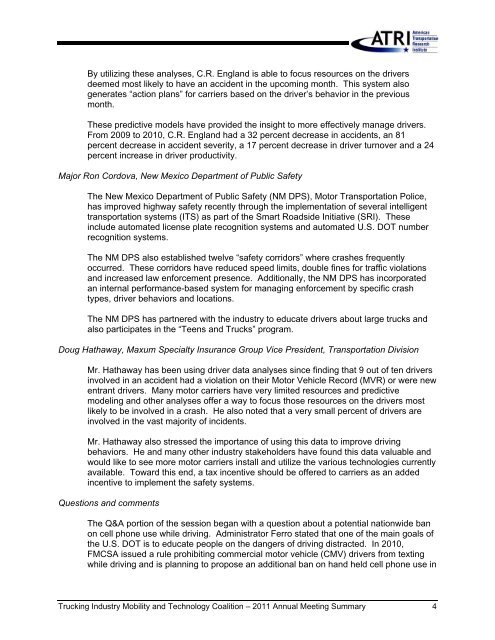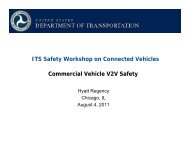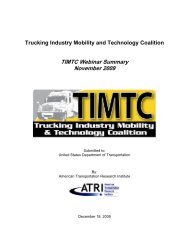Meeting Summary (pdf) - Trucking Industry Mobility and Technology ...
Meeting Summary (pdf) - Trucking Industry Mobility and Technology ...
Meeting Summary (pdf) - Trucking Industry Mobility and Technology ...
You also want an ePaper? Increase the reach of your titles
YUMPU automatically turns print PDFs into web optimized ePapers that Google loves.
By utilizing these analyses, C.R. Engl<strong>and</strong> is able to focus resources on the drivers<br />
deemed most likely to have an accident in the upcoming month. This system also<br />
generates “action plans” for carriers based on the driver’s behavior in the previous<br />
month.<br />
These predictive models have provided the insight to more effectively manage drivers.<br />
From 2009 to 2010, C.R. Engl<strong>and</strong> had a 32 percent decrease in accidents, an 81<br />
percent decrease in accident severity, a 17 percent decrease in driver turnover <strong>and</strong> a 24<br />
percent increase in driver productivity.<br />
Major Ron Cordova, New Mexico Department of Public Safety<br />
The New Mexico Department of Public Safety (NM DPS), Motor Transportation Police,<br />
has improved highway safety recently through the implementation of several intelligent<br />
transportation systems (ITS) as part of the Smart Roadside Initiative (SRI). These<br />
include automated license plate recognition systems <strong>and</strong> automated U.S. DOT number<br />
recognition systems.<br />
The NM DPS also established twelve “safety corridors” where crashes frequently<br />
occurred. These corridors have reduced speed limits, double fines for traffic violations<br />
<strong>and</strong> increased law enforcement presence. Additionally, the NM DPS has incorporated<br />
an internal performance-based system for managing enforcement by specific crash<br />
types, driver behaviors <strong>and</strong> locations.<br />
The NM DPS has partnered with the industry to educate drivers about large trucks <strong>and</strong><br />
also participates in the “Teens <strong>and</strong> Trucks” program.<br />
Doug Hathaway, Maxum Specialty Insurance Group Vice President, Transportation Division<br />
Mr. Hathaway has been using driver data analyses since finding that 9 out of ten drivers<br />
involved in an accident had a violation on their Motor Vehicle Record (MVR) or were new<br />
entrant drivers. Many motor carriers have very limited resources <strong>and</strong> predictive<br />
modeling <strong>and</strong> other analyses offer a way to focus those resources on the drivers most<br />
likely to be involved in a crash. He also noted that a very small percent of drivers are<br />
involved in the vast majority of incidents.<br />
Mr. Hathaway also stressed the importance of using this data to improve driving<br />
behaviors. He <strong>and</strong> many other industry stakeholders have found this data valuable <strong>and</strong><br />
would like to see more motor carriers install <strong>and</strong> utilize the various technologies currently<br />
available. Toward this end, a tax incentive should be offered to carriers as an added<br />
incentive to implement the safety systems.<br />
Questions <strong>and</strong> comments<br />
The Q&A portion of the session began with a question about a potential nationwide ban<br />
on cell phone use while driving. Administrator Ferro stated that one of the main goals of<br />
the U.S. DOT is to educate people on the dangers of driving distracted. In 2010,<br />
FMCSA issued a rule prohibiting commercial motor vehicle (CMV) drivers from texting<br />
while driving <strong>and</strong> is planning to propose an additional ban on h<strong>and</strong> held cell phone use in<br />
<strong>Trucking</strong> <strong>Industry</strong> <strong>Mobility</strong> <strong>and</strong> <strong>Technology</strong> Coalition – 2011 Annual <strong>Meeting</strong> <strong>Summary</strong> 4







